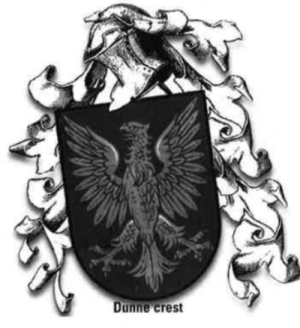he names Dunne and Duffy have nothing in common except that they are derived from colors, the Dunnes from donn, the Gaelic word for brown and Duffy from dubh, the Gaelic for black. This is relatively unusual since the vast majority of Gaelic names are based on relationships i.e. “Son of,” or “Follower of.”
The Dunne family name is derived from the Gaelic O’Duinn or O’Doinn, and originates in County Laois. They were one of the principal Gaelic families of Leinster and the official papers of the English administration in Ireland noted the family as hostile and dangerous to English interests. There is also a Dunn family of Scottish origin some of whom settled in Ulster. In Ireland this name is usually spelled Dunn rather than Dunne, although in the U.S. the distinction is less evident.
Notable Dunnes include Charles Dunn (1799-1872). Born in Kentucky of Dublin parents he became a lawyer in Illinois. In 1836 he was appointed Chief Judge of the New Territory of Wisconsin, a position he held until Wisconsin became a state in 1848. From 1853-56 he also served as a Wisconsin senator. Another Dunne in the legal profession was William McKee Dunne (1814-1887). Born in Indiana he rose to become Judge Advocate General of the U.S. Army in 1875.
Williamson Dunne (1781-1854), who was born in Kentucky, was an early pioneer of Indiana. In 1809 he built the first house in what is now the town of Hanover, and participated in various local Indian wars in the early days of this community. He was eventually elected to the House of Representatives for Indiana.
Finley Peter Dunne (1867-1936): Born in Chicago he went into journalism, rising rapidly in the editorial ranks to become managing editor of the Chicago Journal. At the turn of the century he invented “Dooley” a satirical Irish-American character, whose comments on the political scene were an instant hit with the public. Many Dooley books, as well as newspaper columns (for the Chicago Journal, Colliers and other periodicals), were produced by Finley Peter Dunne during his tenure in Chicago and later New York.
In modern Ireland the Dunne name is well known, and not least because the largest chain of supermarkets is Dunne’s Stores.
The Duffy name is derived from the Gaelic O’Dubhthaig and is mainly associated with County Monaghan. Both forms Duffy and O’Duffy are found in modern Ireland. In Ulster the name has also been transformed to Downey. The Duffys were exceptional craftsmen and worked on many Irish monasteries and churches.
There are several interesting Irish (O) Duffy characters, among whom are General Eoin O’Duffy (1892-1944) who was born in Monaghan and fought in the Irish Independence movement from 1917 to 1921. In 1922 he was made Commissioner of the Garda, the new Irish Police force. In 1933 he was dismissed by Eamon de Valera and he became the leader of the Army Comrades Association, which he gradually turned into an active political force, commonly known as the Blueshirts. This group effectively supported the fascist movements then current in various European countries. In 1933 he became President of the new Fine Gael party but resigned in 1934. During this time he also formed various other pro-fascist groups, which were banned by the government. In 1936 he organized the Irish Brigade to fight with Franco in the Spanish Civil War.
A Duffy with a fascinating career was Charles Gavan Duffy (1816-1903) who was also born in Monaghan. Although having little formal education, he taught himself through extensive reading and became a journalist. In 1842 he founded (with Thomas Davis and others) The Nation, the famous voice of the Young Ireland rebel movement. In 1848, on the eve of the rebellion, he was arrested and The Nation was closed down, only to be revived again on Duffy’s release in 1849. In 1852 he became the Member of Parliament for New Ross.
In 1855, however, he left Ireland and went to Australia. He remained active in politics and in 1871 he became Prime Minister of Victoria and was knighted by the Queen. In 1880 he retired to the south of France and wrote biographies and histories of Irish revolutionary interest.
His son George Gavan Duffy (18821951) became a solicitor in Dublin and was active in the republican movement. In 1921 he was one of the Sinn Fein signatories of the Anglo-Irish Treaty which gave independence to the South of Ireland but which also split the republican movement and caused a brief Civil War. He was later Minister for Foreign Affairs in the first independent Irish government. His sister Louise Gavan Duffy (1884-1969) was also an active republican and educationalist. She was one of the rebel force that occupied Dublin’s General Post Office in 1916. Later she founded Scoil Bridhe, a girls school which taught exclusively through the Irish language.
In the U.S. Duffys have also been prominent in the fight for independence. There were 78 Duffys listed in the American Revolutionary Army. Among these were Captain Patrick Duffy of Proctor’s Pennsylvania Artillery, Timothy Duffy, a surgeon’s mate of Hazen’s Continental Regiment, and Ensign Hugh Duffy of Lancaster Company, Pennsylvania Militia.
Duffy Square, on 43rd Street and Broadway, in New York City was named for the Reverend Francis Duffy, chaplain of the Fighting Sixty-ninth during the First World War. His statue stands there.


Leave a Reply